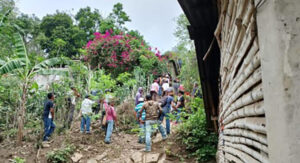
JERUSALEM (BP)–What is believed to be the Pool of Siloam, where Jesus healed a man blind from birth in John 9, has been unearthed in Jerusalem, and a Southern Baptist archeologist is convinced the find is authentic.
“I’ve seen it. It’s a phenomenal, monumental pool,” Steven Ortiz, associate professor of biblical archaeology and director of the Center for Archaeological Research at New Orleans Baptist Theological Seminary, told Baptist Press.
Ortiz made a trip to Israel in recent weeks and walked along the site with one of the field staff working on the excavation.
According to an article in the September/October 2005 issue of Biblical Archeology Review by editor Hershel Shanks, some workers were repairing a sewage line with heavy equipment last summer when they uncovered what appeared to be two steps. Eli Shukron, an archeologist, happened to be watching and immediately notified his colleague, Ronny Reich.
“These must be the steps going down to the Pool of Siloam during the Second Temple Period,” Reich said as soon as he saw the steps, according to Biblical Archeology Review.
As workers continued to dig, they discovered more steps, which grew wider as they went along. Shanks described the site as containing three short segments of descending stairways of five steps each. The first leads down to a narrow landing, the second to another landing and the third down to what is now believed to be the final level — though further excavation may reveal a deeper pool.
Archeologists believe at this time that the pool was at least 225 feet wide at one point, and steps were on at least three sides of the pool. The corners are greater than 90 degrees, indicating the pool was a trapezoid rather than a square, Shanks reported.
Two important bits of information researchers always want to know about a historic site are the date of construction and the date when the facility stopped being used, Shanks wrote. In this case, archeologists have found both. They used a metal detector to discover four coins in the plaster containing the imprint of Alexander Jannaeus, a Jewish king who ruled Jerusalem from 103 to 76 B.C., thereby providing the earliest date the pool could have been constructed. Also, they found a dozen coins from the period of the First Jewish Revolt against Rome, which lasted from A.D. 66 to 70. So archeologists know the pool was used until the end of the revolt, when it was abandoned as mud slid in from the hillside and was no longer cleaned out of the pool. Workers found the pool, located in the lowest spot of Jerusalem, under nearly 10 feet of mud in some places, Shanks noted.
This particular Pool of Siloam, used in Jesus’ day, is different from one that tourists normally visit today, Ortiz said, which was built during the Byzantine era and assumed to be at the original site.
“The traditional pool that everyone currently goes to visit is much smaller, and this newly excavated pool is at least five times as large,” Ortiz said.
But archeologists have not yet concluded whether this pool is located in the same place as the one mentioned in the Old Testament that existed in Hezekiah and Isaiah’s time. They believe that if they can find Iron Age pottery from the sixth to 10th century B.C., then they will have confirmation that the pools share the same location.
“This summer has been a phenomenal time for Jerusalem archeology,” Ortiz said. “You have another excavation just up the hill from the pool where you have possibly a large public building that could be the palace of King David from the Old Testament period. Now you have this pool that dates to the second temple or the New Testament period.”
The large public building from around the 10th century B.C. containing pottery shards that date back to the time of David and Solomon was recently discovered by archeologist Eilat Mazar in East Jerusalem, according to The New York Times Aug. 5. Experts have not yet confirmed whether the building was the palace, but its discovery is certain to play a prominent role in the debate over whether Jerusalem was a mighty capital or a small, provincial town during the 10th century B.C. when David conquered it.
Ortiz noted that the problem with excavating much of Jerusalem is that modern buildings cover the city.
“Jerusalem is a living city, and you have people who are living there and you can’t ask them to move out of their 400-year-old house,” he said.
For now, archeologists have their hands full focusing on the Pool of Siloam, and its discovery could lead to a shift in their thinking about the way Jerusalem worked during the days when Jesus walked its streets. They believe the pool was used as a ritual bath at the time, and Jewish pilgrims were urged to wash themselves in its sacred waters.
John’s gospel records Jesus’ encounter with the blind man. His disciples asked him whether the man or his parents were to blame for his blindness, and Jesus told them the fault belonged to neither. Then He spit on the ground and rubbed the mud on the man’s eyes before telling him to go and wash in the Pool of Siloam, and he was healed.
“Hopefully this [discovery] will encourage [people] to go to Israel and see some of the historical places in the biblical text for themselves,” Ortiz said.
–30–














